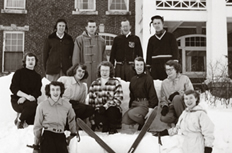PSU students learn about the institution’s “good old days” from the people who were there.
by Kristin Proulx Jarvis

Photo from the 1952 Conning Tower shows devoted skiers in front of Mary Lyon.
What was happening at a small college in Plymouth, N.H., as wars raged around the world, feminism and civil rights took hold and the nature of campus life began to change? These are some of the questions explored in “Beyond the Classroom: Plymouth State, 1938-1975,” an oral history project and exhibit completed last spring by Marcia Schmidt Blaine’s local history methods students.
The course provided students with a chance to experience the design and creation of a local history exhibit from beginning to end. To find out more about dorm life, recreation, athletics and campus events at Plymouth State—as well as what was happening in the rest of the world—students explored the University’s archives, researched oral history methods and interviewed alumni who attended Plymouth State during various times in history. Each student focused on a specific topic, such as athletics, feminism, campus life or recreation.
Students spent hours transcribing the taped interviews (several hours of typing for one hour’s worth of tape), then created large exhibit posters and a PowerPoint presentation, complete with photographs borrowed from old issues of the Conning Tower yearbook, The Clock, Plymouth State catalogs and alumni photo albums. The posters were hung in Lamson Library during finals week last spring and Alumni Weekend in June. The exhibit will be available again for viewing during the 2006 Homecoming and Family Celebration, to be held September 25 to October 1.
The project introduced students to the power of oral history to provide personalized accounts of historical periods, and other details not easily found in books or documents. By the time Stan Lumbra ’06 finished transcribing his lengthy interview with Norton Bagley ’41, he had almost memorized the entire transcript.

World War II Ration Book.
“It was an amazing interview, with an abundance of information,” Lumbra said. “It was interesting to see the close-knit community at Plymouth, and how the outside world affected such a small college.”
Students like Stan were sometimes surprised by what they learned about Plymouth State. During the 1940s and 1950s, for example, Mary Lyon Hall was the social center of campus, housing a dining hall, dorm rooms, gymnasium, ping pong tables and a bowling alley. Female students were not allowed to go downtown without signing out, and most students stayed on campus every weekend. They often spent time after dinner singing around the piano, playing cards or checkers. Trains brought many people to and from campus, and the only women’s athletic programs offered were club teams.
Some things, however, have not changed that much. Back then, and today, Plymouth State students enjoyed the outdoors, especially winter sports. Betty Batchelder ’55, an avid skier and member of the women’s ski club, remembers paying a quarter to ride the rope tow at a ski area in town that no longer exists.
Within this insulated, close-knit college community, echoes from the outside world still affected students’ day-to-day lives. During World War II, students on campus made sacrifices, just as their families back home did.
“I was shocked to find out that during World War II, students had to bring ration books. The campus had a lot of food shortages,” said Kim Watson ’06.
During the 1960s and 1970s, the Plymouth State campus was influenced by the same social, political and military events that were affecting college students across the country. Some exhibit posters explore campus reactions to the Vietnam War and the changing roles of women.
For the alumni who were interviewed, the experience of seeing their memories developed into a display was very rewarding. Several alumni stopped by during the exhibit’s opening on May 15 to reconnect with students and friends, and witness the culmination of the project.
“It was very meaningful, and nice to touch base with what’s going on today,” said Nancy Granger ’59.
Alumni interviewed for this project were Norton Bagley ’41, Marion Pounder ’44, Pat Storer ’48, Henry Vittum ’48, Wilbur Willey ’48, Bill Marston ’54, Betty Batchelder ’55, Nancy Granger ’59, Ed Ashnault ’60, George Davis ’63, Dick Evans ’64, Lee Mason ’65, David Barry ’71, John P. Clark ’71, Bonnie Epstein ’72, Gail Carr ’74, Peter Cofran ’74, Patti Biederman ’76 and Terri Lessard ’76, as well as faculty emerita Dot Diehl.








